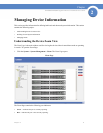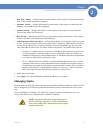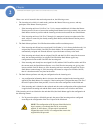
17
Chapter 2:
SFE2000/SFE2000P Gigabit Ethernet Switch Reference Guide
Chapter
2
Stack Unit Startup Process
When a unit in stack mode is initialized (powered up or rebooted), it goes through the following steps:
1. The Master Discovery and Master Election processes.
2. Unit ID allocation by the Stack Master (including duplicate Unit ID conflict resolution).
3. Unit and port configuration by the Stack Master.
Master Discovery Process
When a unit in stack mode initializes, its behavior depends on its Unit ID (if one is configured):
• If the unit does not have a current Unit ID (that is, the unit is in factory default mode) and if there
is a Stack Master, the unit is allocated a Unit ID number from the Stack Master. If there is no
Stack Master, then the unit participates in the Master Election process, and may be chosen as the
new Stack Master or Backup Master.
• If the unit’s current Unit ID is 1 or 2 (that was previously allocated, even if used in a different
stack), then the unit participates in the Master Election process.
• If the unit has a current Unit ID (that was previously allocated, even if used in a different stack),
the unit tries to act according to its Unit ID number in the new stack. For example, if the unit’s
current Unit ID is 3 through 8, it will try to connect to the running Stack Master, and will not
proceed to the next stage until contact with the Stack Master is made. These units will not
participate in the Master Election process, and if no Stack Master is present, the units are
effectively shut down.
The Stack Master and all other stack units carry out a continuous process of Master Discovery by
frequently exchanging stack control messages. This allows units to know if another unit fails or becomes
unreachable.
Master Election Process
When units in stacking mode initialize, one of the units is elected as the Stack Master. If a unit in the
stack was set to “Force Master” by the system administrator, that unit is elected as the Stack Master.
Only master-enabled stack units (for example, those with the Unit ID of 1 or 2) can be configured as
“Force Master.”
If the stack contains units whose unique Unit ID is 1 or 2, then one of these two units will be the Stack
Master. It does not matter if the Unit ID was originally assigned automatically or manually. These units
are called master-enabled units. If there is only one master-enabled unit, it will be elected as the Stack
Master (even if its Unit ID is 2).
If there are two master-enabled units, the two units decide which of them is the Master by checking
which one has been running for a longer time (in intervals of 10 minutes). The unit that has been running
for the longer time will be the Stack Master. If they have been running for the same amount of time, the
unit with the Unit ID of 1 will be the Stack Master. If both units have been running for the same amount
of time and both units have the same Unit ID, the unit with a lower MAC (hardware) address will be
selected as the Stack Master.


















